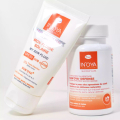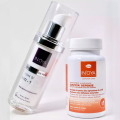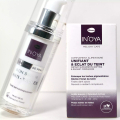Photoprotection for Dark, Olive, and Mixed Skin: Why Protection Must Come from Within
UV Rays Attack Deeply: Pigmented Skin on the Front Line
Each exposure to the sun activates a complex biological process in the skin: inflammation, production of free radicals, disruption of melanin... These phenomena are invisible to the naked eye but have lasting consequences: pigmentation spots, dehydration, accelerated aging.
Contrary to popular belief, dark — black, olive, mixed — skin tones are not better equipped to resist the sun. Their richness in melanin offers partial protection against UVB (sunburn), but lets UVA rays pass through, which are responsible for deep skin aging, dullness, and persistent hyperpigmentation.
A 2022 study (Journal of Clinical and Aesthetic Dermatology) revealed that phototypes IV to VI show a higher rate of post-inflammatory spots following poorly controlled UV exposure, especially on the cheeks, forehead, and upper lip.
Why Topical Protection Alone Is Not Enough
Topical sun care products (creams, fluids, milks) are obviously essential for pigmented skin. But they act only on the surface of the epidermis, like a temporary shield.
However, sun damage in black or mixed skin starts deeper, in the dermis and hypodermis, where UV — especially UVA — penetrates and causes oxidative stress. This alters cells, accelerates skin aging, and triggers excess melanin production, leading to stubborn dark spots.
Therefore, defense must be organized upstream, at the heart of skin cells, to anticipate and limit these aggressions. And this can only come from within.
Nutrition and Photoprotection: What Science Says
Nutrition plays a fundamental role in skin quality. It is estimated that up to 70% of skin health depends on nutritional hygiene (British Journal of Dermatology, 2014).
Certain specific micronutrients can:
- Neutralize UV-induced free radicals (zinc, vitamin C, polyphenols)
- Stimulate cellular repair mechanisms (selenium, vitamin B3)
- Support even and controlled pigmentation (copper)
- Improve skin barrier cohesion (niacinamide)
- Preserve radiance and elasticity (hyaluronic acid, hibiscus)
In other words, strengthening the skin from within not only protects it long-term from sun damage but also prevents pigmentation imbalances that are often difficult to correct once established.
A 2020 meta-analysis (Nutrients Journal) showed that a combined intake of vitamins C, E, zinc, and selenium significantly reduced UV-induced oxidative damage to the skin.
A Lack of Targeted Solutions for Pigmented Skin
Today, most sun supplements available focus on tanning, with ingredients like beta-carotene or lutein, mainly targeting fair skin.
However, the needs of black, olive, and mixed skin tones are different:
- Prevent pigmentation spots
- Reduce post-UV inflammation
- Strengthen skin barriers and cellular regeneration
- Deeply hydrate, as black skin tends to dehydrate faster
This lack of targeted nutritional solutions creates a concerning gap, especially as sun exposure increases (travel, leisure, sports, climate change). It is urgent to rethink sun protection for black skin through a targeted nutritional approach, complementary to classic dermocosmetics.
Towards an "In & Out" Routine: A New Holistic Approach
The new generation of skincare embraces an integrated approach, called "in & out" — meaning from the inside and outside.
This holistic solar skincare approach is based on three pillars:
- Topical protection adapted to phototype (sun fluid, anti-spot, UV filter)
- Internal skin nutrition with antioxidants and protective ingredients (zinc, selenium, vitamin C…)
- A protective lifestyle: hydration, sleep, limiting sugar intake
This combined routine offers global, long-lasting, and more effective sun defense, especially suited to the biological specificities of pigmented skin. It not only reduces spots and inflammation but also preserves youthful, supple, and radiant skin all year round.
The belief that dark skin is immune to sun damage is a persistent — and dangerous — myth. Invisible cellular damage is very real, and nutrition is a key too often overlooked in sun prevention.
Ignoring the impact of nutrients on sun defense is a common mistake with visible consequences: spots, aging, discomfort.
It’s time to recognize that photoprotection for dark, olive, and mixed skin starts from within — and that a well-designed nutritional strategy is now an essential lever to preserve the health, beauty, and even tone of pigmented skin under the sun.
Discover our combined solutions for global sun defense tailored to pigmented skin.
Discover our in and out solutions
Sources
- Journal of Clinical and Aesthetic Dermatology, 2022
- British Journal of Dermatology, 2014
- Nutrients Journal, 2020




